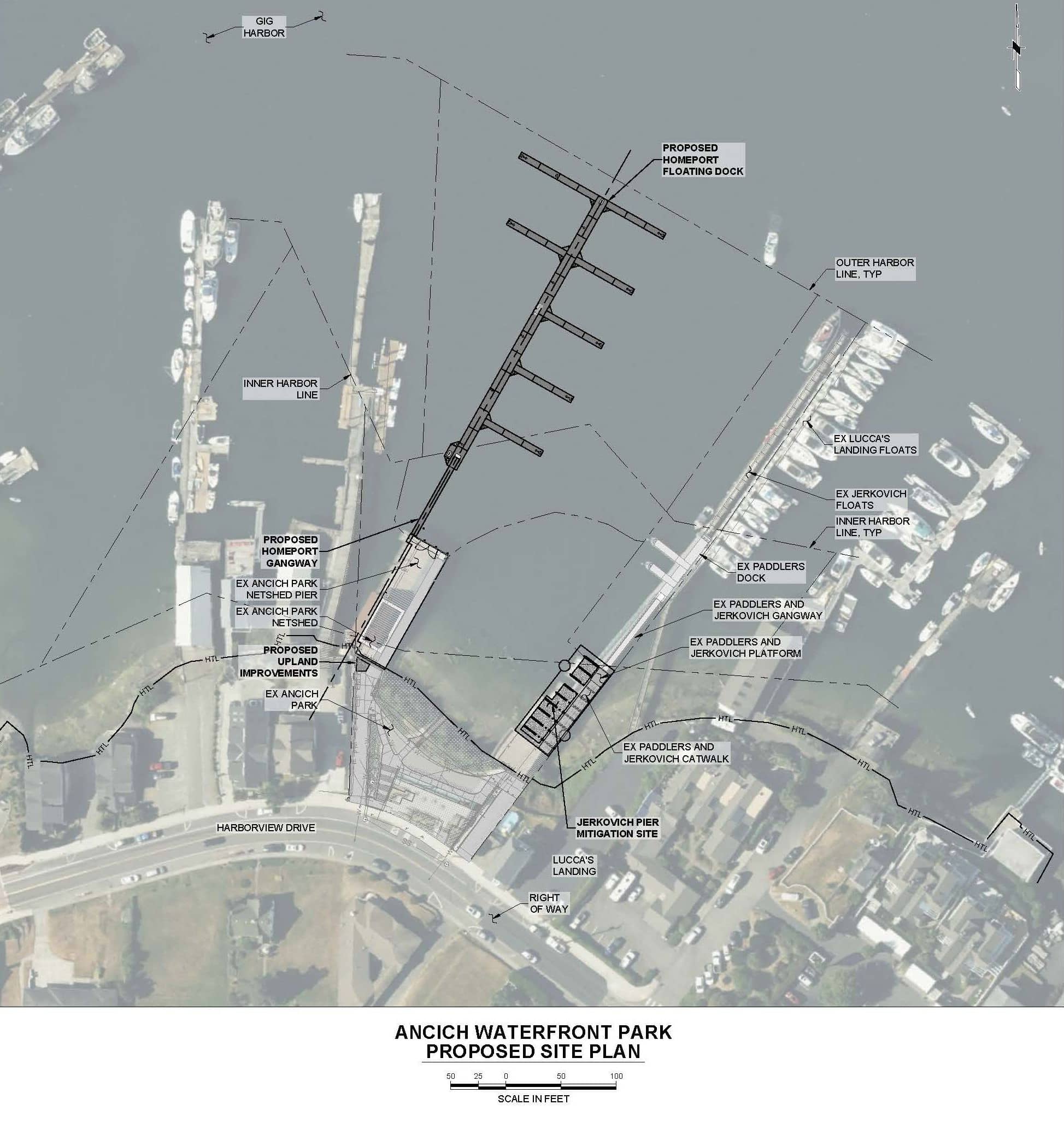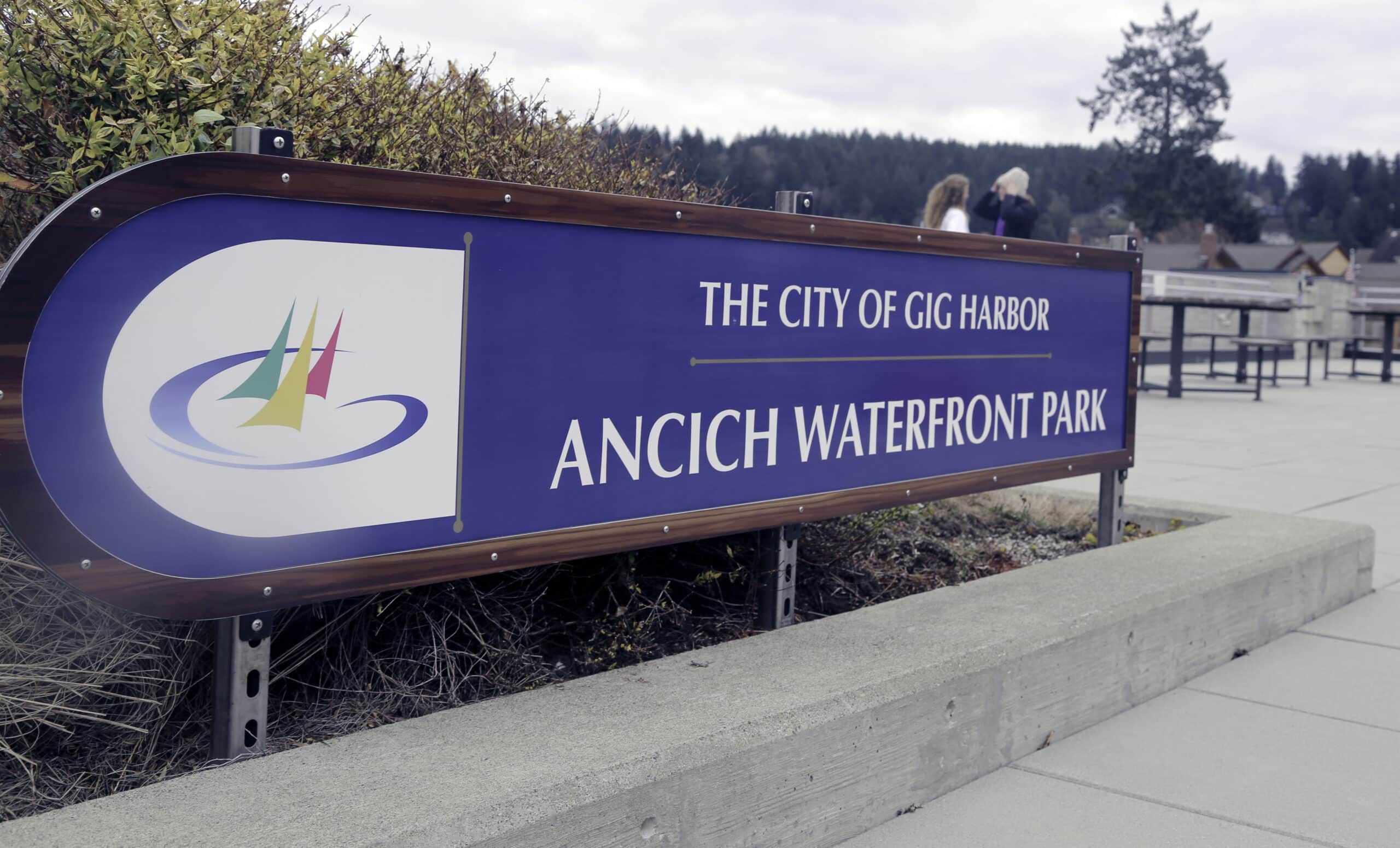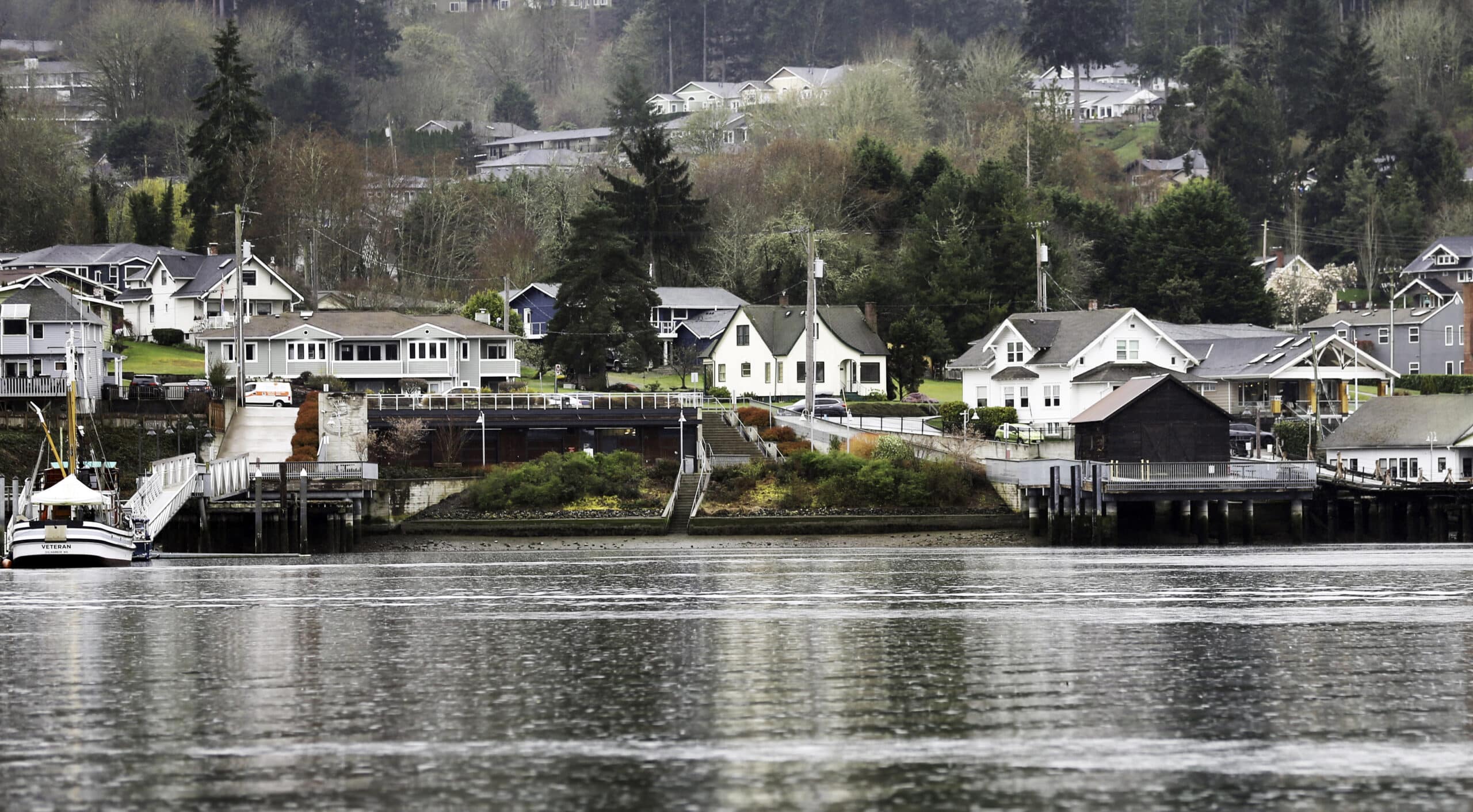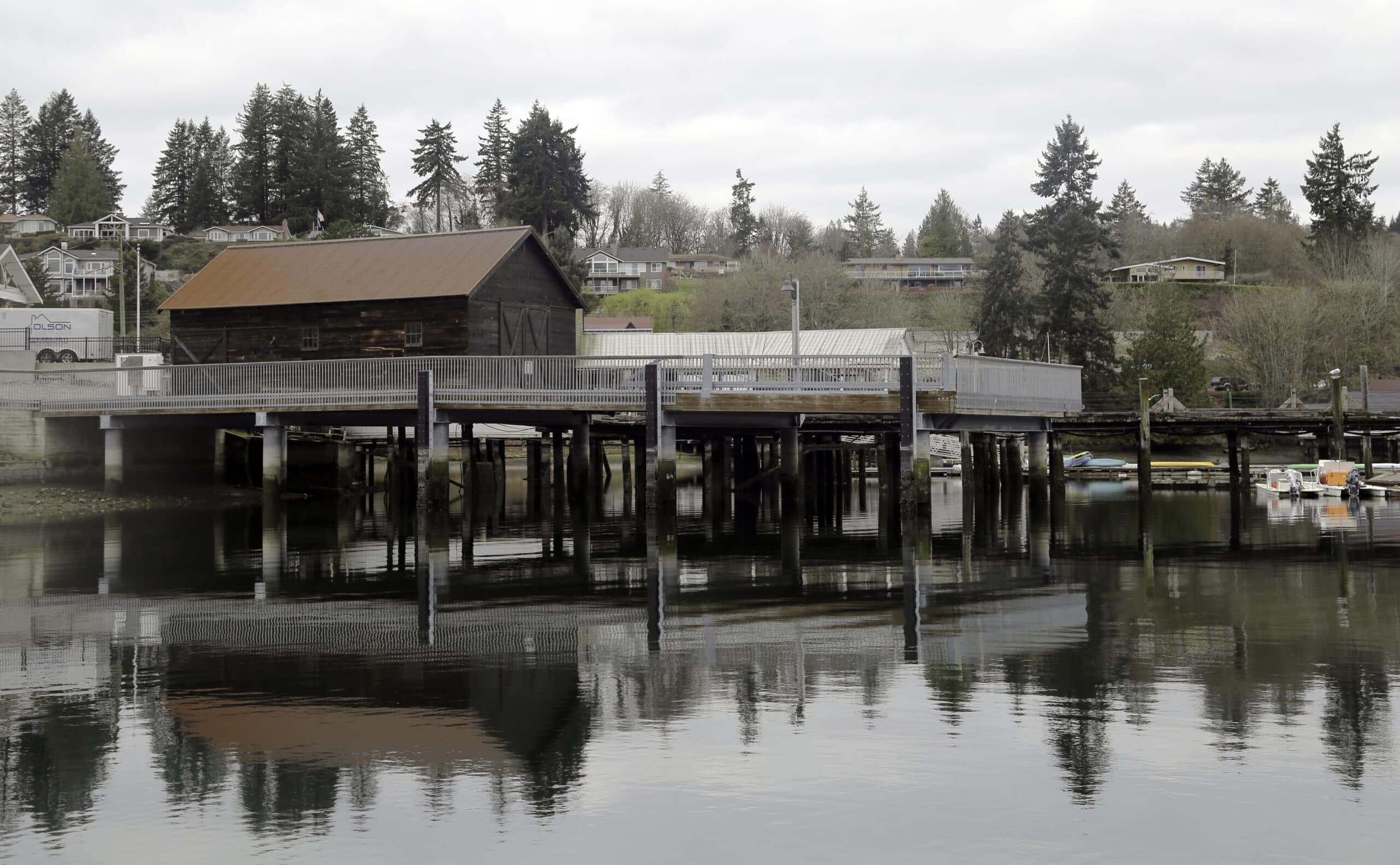Business Community Environment Government
Commercial fishing fleet still waiting for its homeport
Members of Gig Harbor’s fishing fleet have waited more than a decade for the city to build a Commercial Fishing Homeport, which has been part of the plan for Ancich Park since 2013.
It looks like they will have to wait at least another year. Negotiations between the city and the National Marine Fisheries Service over mitigation for the $3.2 million project have stalled. The city likely will miss the so-called “fish window” for overwater construction this year.
The city already has a design, local and state permits, and financing — including a substantial donation from the Gig Harbor Commercial Fishermen’s Club. But it doesn’t have the go-ahead from NMFS, which determines what mitigation is necessary to proceed.
For the local commercial fishing industry, the clock is ticking.
Commercial Fishermen’s Club President Gregg Lovrovich said that if the project doesn’t go forward, the city risks losing its heritage as a fishing town.
“If you don’t build something like that, in 15 years people are going to wonder, ‘There used to be fishing boats here?’” Lovrovich said.

The city of Gig Harbor’s plan for Ancich Park includes the Commercial Fishing Homeport, adjacent to the Paddler’s Dock.
Long-planned project
The homeport would provide moorage for 17 boats from the local commercial fishing fleet. It’s been part of the city’s plans for Ancich since 2013, not long after the city acquired the property for the park.
The city’s Resolution 949 set out a plan for the new park that year. The city has already implemented other facets of the plan.
With funding limited, the city prioritized upland projects at Ancich and construction of the Paddlers Dock, which opened in April 2022. Local commercial fishermen hope their time has finally come.
The public process for planning Ancich was thorough, commercial fisherman Guy Hoppen said.
“It was kind of a big deal” in 2012 and ’13, he said. “That’s why we kind of hang onto the decision that was made then. It was a broadly based community decision by people that chose to participate.”

Ancich Park in Gig Harbor.
Relying on private docks
Currently, Gig Harbor-based commercial fishing boats largely moor at a handful of privately owned docks. It’s an arrangement unique to Gig Harbor — other commercial fishing towns on the West Coast have publicly owned docks, often operated by port districts — and one that’s not sustainable.
“Because eventually, all the private fishing docks are going to be gone,” Lovrovich said, especially when the current fishing generation retires. If the heirs of that generation don’t want to fish, the private docks may no longer be available.
Gig Harbor is part of the Tacoma Port District, which awarded the city a $150,000 Local Economic Development Impact Fund grant for the commercial fishing homeport. It was the port’s largest LEDIF grant in 2023.
The Fishermen’s Club chipped in another $200,000. The balance of the funding, already budgeted, will come from the city’s portion of the real estate excise tax.
Proceeds from the REET tax, according to city ordinance, may be used “solely for the financing of capital projects specified in a capital facilities plan element of a comprehensive plan” approved by the city council. REET proceeds cannot go to the city’s general fund, which is facing a budget shortfall of $2 million starting in 2025.
‘A moving target’
The long delay since the city resolved to build the homeport is a source of frustration for commercial fishermen. City officials also sound a little frustrated over the current hold-up.
The city’s mitigation proposal to NMFS included removal of the creosote-covered Jerkovich Pier. But the goalposts have moved since the city first submitted its application, according to Gig Harbor Public Works Director Jeff Langhelm.
“When the city submitted permit applications to the federal government for this project almost two years ago, the formulas used by NMFS to calculate mitigation were different than the formulas used by NMFS today,” Langhelm wrote in an email responding to questions from Gig Harbor Now.
“At this point the city believes the mitigation proposed by NMFS is excessive, not proportionate, and is a moving target.”
Langhelm added that the city is “committed to working with NMFS to find fair and proportionate mitigation for the Commercial Fishing Homeport project.”

Ancich Park as seen from the eastern shore of Gig Harbor. City plans call for the Commercial Fishing Homeport on the right of this image.
Prioritizing local fishermen
Assuming the homeport gets built, Gig Harbor would be the only city in Washington state to operate its own commercial fishing homeport.
A fact which doesn’t concern the city at all, since it already operates numerous other over-water facilities. They include Jerisich Dock and the Maritime Pier.
“We’re very familiar with over-water structures,” Langhelm said.
And city officials are confident they won’t have trouble finding boats to fill the 17 slips. Similar facilities around the region have waiting lists.
The city and the fishermen’s club agree that local boats should receive priority for the 17 spaces at the new homeport. They haven’t worked out exactly how to do that. It likely will grant priority to operators based in Gig Harbor-area zip codes.
If any slips remain – or if the city needs to winnow the pool of local applications – a lottery system is an option.
Moorage rates and security
The city has not finalized moorage rates, but at a council study session last year staff noted that the average rate of seven port districts in Washington that operate similar facilities is $8.73 per foot per month. At that rate, Langhelm said, the commercial fishing homeport would pay for itself before the end of its expected 50-year lifespan.
The homeport would host commercial boats of less than 80 feet. Local fishing fleet boats are well under that threshold.
The city does not plan to allow transient moorage at the commercial fishing homeport, even when fishing boats are away in the summer. Mayor Tracie Markley said some neighbors opposed the idea. The city also had safety concerns about recreational boaters operating so close to the Paddler’s Dock, a launching site for kayaks and similar craft.
Commercial fishing boat owners would pay for their moorage year-round, though, to hold their spot.
Public access
The city is still working out how to handle public access to the homeport. City officials at one point suggested putting a locked gate on the facility, citing insurance liability concerns.
The Commercial Fishing Club isn’t that worried. Lovrovich pointed out that if anyone really wants to get onto a dock, they can paddle up in a kayak or rowboat.
In fact, local commercial fishermen see a public benefit in allowing access to the dock, at least during daylight hours.
“We’ve always thought that the public access to the fishermen at work on the pier and in the Ancich shed would be the most compelling thing … That’s one of the benefits for the community,” Hoppen said. “They can come down and interact with the fishermen at work.”
Officials have discussed inviting school or community groups, for instance, to visit the homeport to learn about the commercial fishing industry and its place in Gig Harbor’s history.
Economic impact
Retaining a link between the city and its commercial fishing heritage was central to the decision over a decade ago to build the facility.
However, the city’s 2020 feasibility study on the homeport downplays the economic impact it would have on the community.
That study uses terms like “relatively low” and “limited” to describe the homeport’s economic impacts. Hoppen, who wrote a graduate thesis touching on Ancich Park and the local commercial fishing industry, strenuously disagrees with the study’s conclusions on economic impact.
“Local fishing vessels inject many times the amount of money as local pleasure craft into our local economy,” according to a document prepared by Hoppen and Lovrovich detailing the homeport’s benefits. They cite research conducted for a Port of Seattle report showing that a single commercial fishing boat provides an economic impact equivalent to 33 recreational craft.

Ancich Park in Gig Harbor.
“Not every penny might be spent here in Gig Harbor, but we buy our groceries here,” Lovrovich said. “We hire our crew here. We spend our money here in Gig Harbor.”
Despite the feasibility study conclusions, city leaders remain confident that the homeport and the continued presence of a commercial fishing fleet will benefit Gig Harbor.
“The council feels this will bring people to Ancich Park to see fishermen fixing their nets” and performing other tasks, Markley said. “This will bring people downtown. … There will be an economic impact. We just don’t know what that will be (exactly). But there is thought that there will be an economic impact to the city.”
Heritage and legacy
In any case, advocates for the homeport believe economic impact is almost beside the point. The word “legacy” comes up a lot when discussing the commercial fishing homeport.
Lovrovich points to the photos and paintings of commercial fishing boats adorning the walls of restaurants and galleries around town.
“People hang on to the fishing industry,” Lovrovich said. “If something like that’s not built, they’ll wonder why are there (pictures of) fishing boats?
Political leaders at the city are aware of how high a priority the project is for local commercial fishermen.
“This means a great deal to them,” Markley said. “I can say from personal conversations I’ve had with the fishermen, they’ve been waiting for this for a very long time. This is incredibly important to their families and the legacy they want to leave in Gig Harbor.”
Hoppen said the project “speaks to heritage” and a sense of place that is unique in the South Sound region. Without the homeport, he predicts the Gig Harbor commercial fishing fleet will disappear within the next decade.
“For a long time, you couldn’t predict the demise,” he said. “Now, you can see it.”
